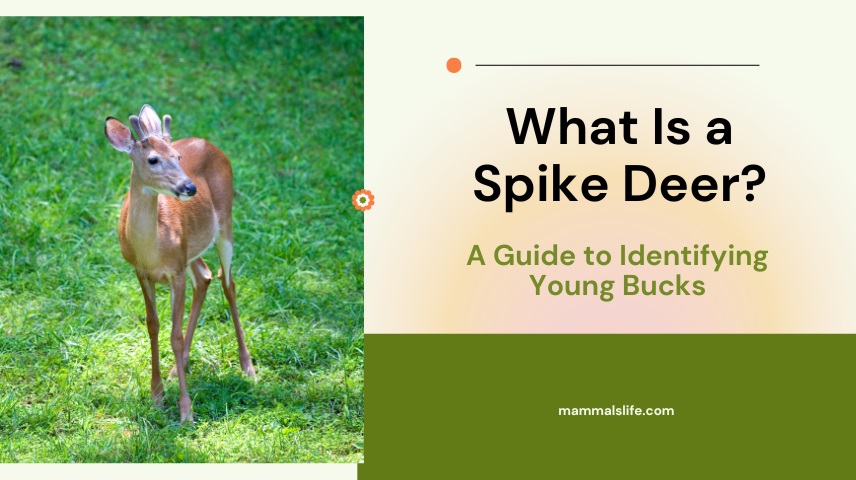Last Updated on February 22, 2025 by Mammals Life
Deer freeze in headlights due to their instinctual response to perceived threats. This reaction helps them assess danger.
Deer possess a unique survival mechanism that causes them to freeze when confronted with sudden, bright lights. This behavior stems from their natural predator-avoidance instincts. Their eyes are adapted for low-light conditions, which makes them sensitive to intense light sources like car headlights.
When faced with such stimuli, they momentarily pause to evaluate the situation. This split-second decision-making process aims to protect them from potential dangers. Understanding this instinctual response is crucial for drivers, helping to mitigate the risk of accidents. By being aware of this behavior, we can take preventive measures and ensure safer roads for humans and wildlife.
Instinctual Behavior
Deer freezing in headlights is a common sight. This behavior is deeply rooted in their instinctual nature. Understanding why deer react this way can help prevent accidents. Let’s delve into the core reasons behind this instinctual behavior.
Fight Or Flight
Deer rely on their fight or flight response for survival. When a threat appears, their bodies prepare to either confront or flee. This response is automatic and happens without conscious thought.
In the wild, this reaction serves them well. Their quick decision-making helps them evade predators. The dilemma arises when facing car headlights. The bright lights trigger their survival instincts.
Deer often freeze because their brains get overwhelmed. The intense light confuses them. They can’t decide whether to fight or flee. This momentary paralysis can last several seconds. During this time, they are highly vulnerable.
Read More – Can Deer See Green Light? Exploring How Deer Respond to Different Colors
Evolutionary Traits
The freezing response is an evolutionary trait in deer. Over centuries, this instinct has helped them survive. Early deer who froze in danger often avoided detection. This trait got passed down through generations.
Deer’s eyes are adapted for low-light conditions. Their vision is sensitive to sudden light changes. Car headlights create a blinding effect. This sudden brightness can trigger their freeze response.
In addition to their vision, deer have a strong startle reflex. This reflex helps them react quickly to threats. When startled by headlights, they freeze as part of this reflex.
Let’s summarize the key points in a table:
| Instinctual Behavior | Impact on Deer |
|---|---|
| Fight or Flight | Triggers freeze response due to overwhelming light |
| Evolutionary Traits | Freezing helps avoid detection; sensitive vision to light |
Understanding these behaviors can help drivers be more cautious. Awareness can reduce deer-related accidents. Always stay alert in areas where deer are common.
Visual Perception
Deer have unique visual perception that plays a key role in their behavior. Understanding their vision helps explain why they freeze in headlights. Their eyes are specially adapted for their environment.
Night Vision
Deer are crepuscular, meaning they are active during dawn and dusk. Their eyes are adapted for low light. They have more rods than cones in their retinas. Rods are light-sensitive cells. This gives them excellent night vision.
Deer also have a reflective layer behind their retina. This layer is called the tapetum lucidum. It reflects light through the retina. This improves their ability to see in the dark.
Light Sensitivity
Deer eyes are very sensitive to light. Bright lights can be overwhelming for them. This is why they freeze when headlights shine on them. Their eyes cannot adjust quickly to sudden brightness.
When a car’s headlights hit a deer’s eyes, it creates a blinding effect. The deer becomes disoriented. They stand still, unable to move. This instinctual response helps them stay safe in the wild but can be dangerous on roads.
| Feature | Deer | Humans |
|---|---|---|
| Rods vs. Cones | More rods | More cones |
| Tapetum Lucidum | Present | Absent |
| Light Sensitivity | High | Moderate |
Read More – Can Deer See Red Light? Exploring Deer Vision And Light Sensitivity
Role Of Predators
Understanding why deer freeze in headlights involves exploring their instinctual responses. The role of predators plays a crucial part in this behavior. Deer have evolved to react quickly to threats. This response helps them survive in the wild.
Predator Detection
Deer possess keen senses to detect predators. Their large eyes provide a wide field of vision. This helps them spot danger quickly. They also have an acute sense of hearing. This allows them to hear predators from a distance. Deer rely on these senses to stay safe.
When a deer sees or hears a predator, it must decide quickly. It can flee, fight, or freeze. Freezing helps a deer avoid detection. Predators often miss stationary prey. This instinct can save a deer’s life.
Historical Context
Deer have faced predators for millions of years. Early predators included large cats and wolves. These predators hunted by sight and sound. Freezing became a survival tactic for deer. This behavior has been passed down through generations.
Modern-day predators still hunt deer. These include coyotes, bears, and humans. Deer continue to use their instinctual freeze response. This natural reaction is deeply ingrained. It helps them survive in today’s world.
Understanding the role of predators is key. It explains why deer freeze in headlights. This behavior is an ancient survival strategy.
Impact Of Car Headlights
The impact of car headlights on deer is significant. When a car’s lights hit them, they often freeze. This reaction is due to several factors, including the intensity of the light and the sudden exposure to it.
Light Intensity
Car headlights are very bright. Deer have large eyes with many rod cells. These cells help them see well in low light. But they are sensitive to bright light. When headlights shine on them, it overwhelms their vision.
In low light, deer rely on their rods for vision. Bright lights from cars can cause temporary blindness. The intense light makes them confused and unable to move.
Sudden Exposure
Deer often experience sudden exposure to car headlights. This surprises them and triggers a freeze response. This response is an instinct to avoid predators.
Deer are prey animals. Their instinct is to stay still when threatened. Sudden bright lights mimic this threat. They freeze to avoid being seen by predators.
Here is a table to summarize the impact:
| Factors | Effects on Deer |
|---|---|
| Light Intensity | Overwhelms vision, causes confusion |
| Sudden Exposure | Triggers freeze response, mimics predator threat |
Understanding these factors can help drivers be more aware. Slowing down in areas with deer can prevent accidents. Use high beams sparingly to avoid startling deer.
Read More – What Does It Mean When a Deer Blows? Exploring the Reasons Behind This Common Deer Reaction
Biological Mechanisms
Have you ever wondered why deer freeze in headlights? This curious behavior has puzzled many drivers. The answer lies in the biological mechanisms of deer. Their bodies and brains react instinctively to sudden lights. Let’s explore these mechanisms in detail.
Neurological Responses
Deer’s brains are wired to respond quickly to danger. The sudden appearance of headlights triggers their fight-or-flight response. The sympathetic nervous system controls this. When the bright light hits their eyes, their brains receive a shock. This shock makes them freeze. They can’t decide whether to run or stay still.
Their visual processing is slower than that of humans. Deer see better in low light, not bright light. The sudden brightness overwhelms their vision. This causes them to stand still, trying to understand what is happening.
Muscle Control
Freezing in place also involves the deer’s muscle control. When they are shocked, their muscles tense up. This is an automatic response to danger. Their muscles lock up, making it hard to move.
The muscle tension helps them stay alert. It prepares them to run if needed. But in the moment, it makes them freeze. This is a survival tactic. By staying still, they hope to avoid detection by predators.
Muscle control and neurological responses work together. They create the instinctual freezing behavior we see in deer. Understanding these biological mechanisms helps us appreciate these animals better.
Safety Measures
Understanding why deer freeze in headlights can save lives. Drivers must take certain safety measures to avoid accidents. Below are essential tips and strategies for both drivers and pedestrians.
Driver Awareness
Drivers need to be aware of their surroundings. Deer are most active during dawn and dusk. Slow down during these times to avoid sudden encounters.
Use high-beam headlights when driving in rural areas. This can help you see deer from a distance. But remember to dim them when another car approaches.
Always be vigilant for “Deer Crossing” signs. These signs are placed in areas where deer are known to cross the road.
Preventive Actions
Taking preventive actions can greatly reduce the risk of accidents. Here are some key steps:
- Install deer whistles on your vehicle. These devices emit a sound that can alert deer.
- Maintain a safe speed especially in areas with dense vegetation.
- Keep your windshield clean for better visibility.
If you spot a deer, brake firmly and do not swerve. Swerving can lead to more severe accidents. Use your horn to scare the deer away.
If you see one deer, expect more. Deer often travel in groups. Stay cautious and prepared for sudden movements.
By following these safety measures, you can reduce the risk of accidents. Protect yourself, your passengers, and the deer.
Frequently Asked Questions
Why Do Deer Freeze When Seeing Headlights?
Deer freeze when seeing headlights because they become disoriented. Their eyes are adapted for low light, so bright lights blind them temporarily.
What Causes Deer To Freeze?
Deer freeze due to a fear response called “freezing behavior. ” This instinct helps them avoid detection by predators.
Why Do Deer Get Caught In The Headlights?
Deer get caught in headlights because their eyes are adapted to low light, causing them to freeze in bright lights. This reaction is a defense mechanism, making them temporarily immobile.
What Is The Science Behind Deer In Headlights?
Deer freeze in headlights due to a defense mechanism. Bright lights stun and confuse them, causing temporary paralysis.
Why Do Deer Freeze In Headlights?
Deer freeze in headlights due to a defense mechanism. Their eyes are sensitive to light, causing them to stop.
Is Freezing A Survival Instinct For Deer?
Yes, freezing is a survival instinct. It helps deer avoid predators by making them less noticeable.
Conclusion
Deer freeze in headlights due to their instinctual response. This behavior helps them detect predators. Understanding this can help drivers avoid accidents. Being aware of deer behavior can save lives. Always stay alert when driving through deer-populated areas. Drive safely to protect both humans and wildlife.











